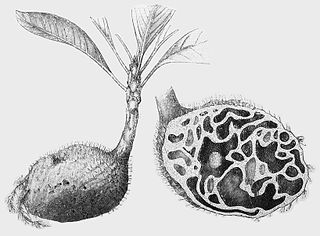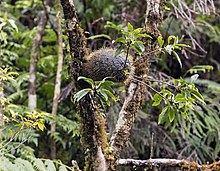
The Rubiaceae are a family of flowering plants, commonly known as the coffee, madder, or bedstraw family. It consists of terrestrial trees, shrubs, lianas, or herbs that are recognizable by simple, opposite leaves with interpetiolar stipules and sympetalous actinomorphic flowers. The family contains about 13,500 species in about 620 genera, which makes it the fourth-largest angiosperm family. Rubiaceae has a cosmopolitan distribution; however, the largest species diversity is concentrated in the tropics and subtropics. Economically important genera include Coffea, the source of coffee, Cinchona, the source of the antimalarial alkaloid quinine, ornamental cultivars, and historically some dye plants.

Matthew Hilary Peter Jebb is an Irish botanist and taxonomist specialising in the ant plant genera Squamellaria, Myrmecodia, Hydnophytum, Myrmephytum and Anthorrhiza, as well as the carnivorous plant genus Nepenthes.

Myrmecodia is a genus of epiphytic myrmecophytes, native to Southeast Asia and present in Indochina, Malaysia, the Southwest Pacific, the Philippines, and extending south to Fiji and Cape York in Queensland, Australia. It is one of five ant-plant genera in the family Rubiaceae, the others being Anthorrhiza, Hydnophytum, Myrmephytum, and Squamellaria.

Clinostigma is a genus of flowering plants in the Arecaceae (palm) family. It is native to various islands in the western Pacific.

Neoveitchia is a genus of palm trees. It contains two known species, native to certain islands in the western Pacific:
Physokentia is a genus of flowering plant in the palm family, native to certain islands of the western Pacific.

Ptychosperma is a genus of flowering plant in the family Arecaceae. Most are native to Australia and/or New Guinea, with a few in the Solomon Islands and in Maluku Province of eastern Indonesia. Some have been cultivated abroad as house or garden plants, and reportedly naturalized in certain regions

Veitchia is a genus of flowering plant in the family Arecaceae.

Balaka is a genus of 9 known species in the palm family, Arecaceae or Palmae. Seven species are native to the islands of Fiji and two to Samoa. The genus was first proposed and published in Annales du Jardin Botanique de Buitenzorg 2: 91. 1885, from two species originally in the genus Ptychosperma.

Heterospathe is a monoecious genus of flowering plant in the palm family found in Oceania, where it is called sagisi palm. With 39 species, Heterospathe is named from a Greek combination of "various" and "spathe", which describes the two distinct bract types.

Hydriastele is a diverse and widespread genus of flowering plant in the palm family found throughout northern Australia, Melanesia, Polynesia, and Southeast Asia. It consisted of just nine species until 2004, when molecular research, supported by morphologic similarities, led taxonomists to include the members of the Gulubia, Gronophyllum, and Siphokentia genera. About 40 species are now recognized.

Atractocarpus is a genus of flowering plants in the family Rubiaceae. Its members are commonly known as native gardenias in Australia. The genus name is derived from the Ancient Greek terms atractos "spindle", and karpos "fruit", from the spindle-shaped fruit of the type species.

Hydnophytum is a genus of epiphytic myrmecophytes native to Southeast Asia, the Pacific region and also extending into Queensland in northern Australia. The name is derived from the Ancient Greek hydnon "tuber", and phyton "plant", after their appearance with their swollen succulent stems. The species grow in tree branches and on trunks. Like the related genus Myrmecodia, they are known as antplants or ant-house plants. The type species is Hydnophytum formicarum from the Philippines. The genus contains 55 species, of which 44 are found in and around the island of New Guinea. Many are poorly known, with 11 known only from the holotype.

Sciaphila is a genus of mycoheterotrophic plants in the family Triuridaceae. These plants receive nutrition from fungi and neighboring trees and have less need for photosynthesis. It is widespread in tropical and subtropical regions, found in Africa, China, Japan, the Indian Subcontinent, Southeast Asia, Latin America and on various islands Pacific Islands. The most noteworthy feature of the genus is the number of the various flower parts 99.9 percent of Monocots are trimerous, but Sciaphila spp. can have eight or even ten parts in a whorl.
Anthorrhiza is a genus of myrmecophytic flowering plants in the family Rubiaceae. It is endemic to Papua New Guinea, including the Louisiade Archipelago. It is one of five ant-plant genera in the family Rubiaceae, the others being Hydnophytum, Myrmecodia, Myrmephytum, and Squamellaria.
Myrmephytum is a genus of myrmecophytic flowering plants in the family Rubiaceae. It is distributed from central Malesia to New Guinea.

Psychotrieae is a tribe of flowering plants in the family Rubiaceae and contains about 2114 species in 17 genera. Its representatives are found in the tropics and subtropics. Several genera are Myrmecophytes

Philidris cordata is a species of ant in the genus Philidris. Described by Smith in 1859, the species is endemic to Indonesia and New Guinea. This species is a frequent inhabitant of the ant plant genera: Myrmecodia and Hydnophytum.
Philidris nagasau is a species of ant in the genus Philidris. Described by William M. Mann in 1921, the species is endemic to Fiji.

Calamus vitiensis, commonly known as the Dunk Island lawyer vine, solitary lawyer vine or Mission Beach wait-a-while, is a climbing palm in the family Arecaceae. It grows in rainforests from the Maluku Islands east through New Guinea and the Solomon Islands to Fiji and Vanuatu, and south to Queensland, Australia.
















